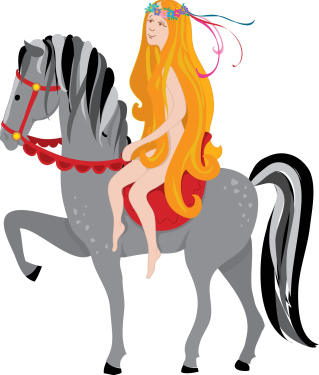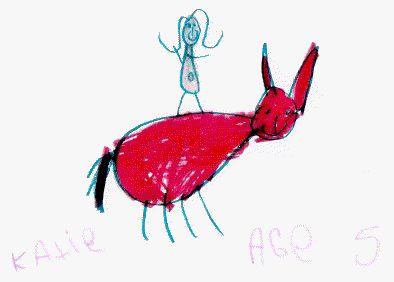Lady Godiva
The story of Lady Godiva and her legendary naked horseback ride through the streets of Coventry is told here in the form of a children's poem, by British children's writer Paul Perro.
Everyone knows the story of Lady Godiva, but do you know who she was or why she did it? Well, Godiva was a good woman who carried out her daring stunt to help the poor people of her home town. Paul Perro's poem below tells the story in a fun way.
Did it really happen or is it a myth? Well, possibly a little of both. To help you decide, we have collected some interesting facts at the bottom of this page. After you have enjoyed the poem, keep scrolling down to find out more.
Lady Godiva
a poem for kids by Paul Perro
Leofric was a rich man
And he lived in Coventry.
His wife was called Godiva
And she was as kind as could be.
Godiva said to her husband one day
“It’s a terrible thing I’m sure
That we have so much money
While everyone else is poor.
Perhaps we can give some money away
To help the hungry and needy.
We can keep a little bit for ourselves
But I think we should stop being greedy.”
Her husband laughed and said “My dear,
Stay away from my moneybox!
You wouldn’t last five minutes
If we couldn’t afford your fine frocks.”
Godiva thought for a while then said,
“Let us both take oaths
That we will give our money away
If I can prove I don’t need clothes.”
The next day she got on her horse
And let down her long hair.
Nobody could believe what they saw,
Godiva was totally bare.
“We must avert our eyes” said one,
“Or else it would be rude.
It’s not polite to stare at a lady
When she is in the nude.”
So everybody looked away
Apart from Peeping Tom.
He had a sneaky peak and saw
Lady Godiva’s bum.
When Godiva got back home
Her husband said “I guess
We’ll have to give our money away.
You’ve proved you don’t need your dress”
Facts about Lady Godiva

- In Anglo-Saxon, Godiva's name was Godgifu, meaning "God's gift."
- She was married to Leofric of Mercia, a powerful earl who controlled most of central England, a friend of the king, Edward the Confessor.
- The legend has it that Godiva, a generous and kind-hearted lady, accepted a challenge from her husband, that if she rode naked through the streets of Coventry, he would reduce taxes for the commoners. She won the bet, letting down her long hair to cover her body so that no-one saw her nakedness.
- The events of the story are believed to have taken place in 1043 AD.
- Historians now think it more likely that "naked" just meant dressed plainly and without her jewelry on. The idea of her taking all her clothes off would have been unthinkable to a pious Anglo-Saxon lady.
- Over the centuries, parts of the legend changed in the retelling. A 17th century version of the story has all the citizens of Coventry averting their eyes in solidarity with Lady Godiva's protest...all the citizens except one. A tailor called Thomas, has a sneaky look. He is punished for his curiosity though, by being struck blind (or struck dead, depending on who was telling the story). This unfortunate character gives us the expression "Peeping Tom."
- Godiva processions have been held regularly (sometimes annually) in Coventry, to commemorate her protest, since the 17th century. Sometimes the actress playing Godiva has worn a tight fitting flesh coloured dress, and fights have been known to break out in the crowd among young men keen to get a better view.
- In 1949 a bronze statue of Lady Godiva was unveiled in the centre of the city.





